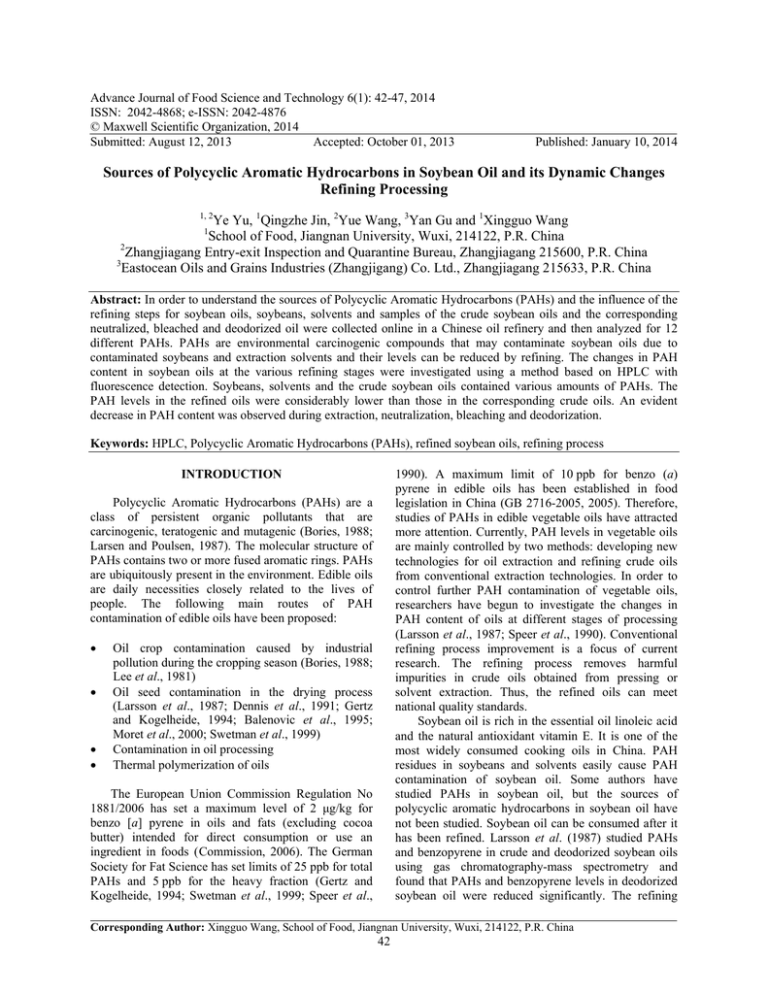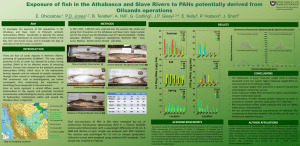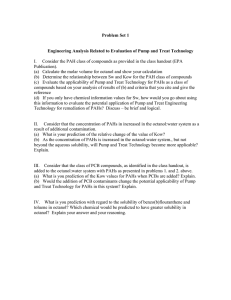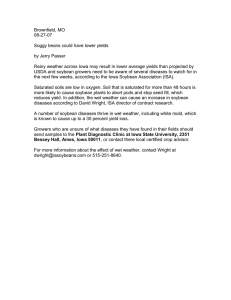Advance Journal of Food Science and Technology 6(1): 42-47, 2014
advertisement

Advance Journal of Food Science and Technology 6(1): 42-47, 2014 ISSN: 2042-4868; e-ISSN: 2042-4876 © Maxwell Scientific Organization, 2014 Submitted: August 12, 2013 Accepted: October 01, 2013 Published: January 10, 2014 Sources of Polycyclic Aromatic Hydrocarbons in Soybean Oil and its Dynamic Changes Refining Processing 1, 2 Ye Yu, 1Qingzhe Jin, 2Yue Wang, 3Yan Gu and 1Xingguo Wang School of Food, Jiangnan University, Wuxi, 214122, P.R. China 2 Zhangjiagang Entry-exit Inspection and Quarantine Bureau, Zhangjiagang 215600, P.R. China 3 Eastocean Oils and Grains Industries (Zhangjigang) Co. Ltd., Zhangjiagang 215633, P.R. China 1 Abstract: In order to understand the sources of Polycyclic Aromatic Hydrocarbons (PAHs) and the influence of the refining steps for soybean oils, soybeans, solvents and samples of the crude soybean oils and the corresponding neutralized, bleached and deodorized oil were collected online in a Chinese oil refinery and then analyzed for 12 different PAHs. PAHs are environmental carcinogenic compounds that may contaminate soybean oils due to contaminated soybeans and extraction solvents and their levels can be reduced by refining. The changes in PAH content in soybean oils at the various refining stages were investigated using a method based on HPLC with fluorescence detection. Soybeans, solvents and the crude soybean oils contained various amounts of PAHs. The PAH levels in the refined oils were considerably lower than those in the corresponding crude oils. An evident decrease in PAH content was observed during extraction, neutralization, bleaching and deodorization. Keywords: HPLC, Polycyclic Aromatic Hydrocarbons (PAHs), refined soybean oils, refining process 1990). A maximum limit of 10 ppb for benzo (a) pyrene in edible oils has been established in food legislation in China (GB 2716-2005, 2005). Therefore, studies of PAHs in edible vegetable oils have attracted more attention. Currently, PAH levels in vegetable oils are mainly controlled by two methods: developing new technologies for oil extraction and refining crude oils from conventional extraction technologies. In order to control further PAH contamination of vegetable oils, researchers have begun to investigate the changes in PAH content of oils at different stages of processing (Larsson et al., 1987; Speer et al., 1990). Conventional refining process improvement is a focus of current research. The refining process removes harmful impurities in crude oils obtained from pressing or solvent extraction. Thus, the refined oils can meet national quality standards. Soybean oil is rich in the essential oil linoleic acid and the natural antioxidant vitamin E. It is one of the most widely consumed cooking oils in China. PAH residues in soybeans and solvents easily cause PAH contamination of soybean oil. Some authors have studied PAHs in soybean oil, but the sources of polycyclic aromatic hydrocarbons in soybean oil have not been studied. Soybean oil can be consumed after it has been refined. Larsson et al. (1987) studied PAHs and benzopyrene in crude and deodorized soybean oils using gas chromatography-mass spectrometry and found that PAHs and benzopyrene levels in deodorized soybean oil were reduced significantly. The refining INTRODUCTION Polycyclic Aromatic Hydrocarbons (PAHs) are a class of persistent organic pollutants that are carcinogenic, teratogenic and mutagenic (Bories, 1988; Larsen and Poulsen, 1987). The molecular structure of PAHs contains two or more fused aromatic rings. PAHs are ubiquitously present in the environment. Edible oils are daily necessities closely related to the lives of people. The following main routes of PAH contamination of edible oils have been proposed: • • • • Oil crop contamination caused by industrial pollution during the cropping season (Bories, 1988; Lee et al., 1981) Oil seed contamination in the drying process (Larsson et al., 1987; Dennis et al., 1991; Gertz and Kogelheide, 1994; Balenovic et al., 1995; Moret et al., 2000; Swetman et al., 1999) Contamination in oil processing Thermal polymerization of oils The European Union Commission Regulation No 1881/2006 has set a maximum level of 2 μg/kg for benzo [a] pyrene in oils and fats (excluding cocoa butter) intended for direct consumption or use an ingredient in foods (Commission, 2006). The German Society for Fat Science has set limits of 25 ppb for total PAHs and 5 ppb for the heavy fraction (Gertz and Kogelheide, 1994; Swetman et al., 1999; Speer et al., Corresponding Author: Xingguo Wang, School of Food, Jiangnan University, Wuxi, 214122, P.R. China 42 Adv. J. Food Sci. Technol., 6(1): 42-47, 2014 Table 1: Excitation and emission wavelengths program Time (min) Excitation (nm) Emission (nm) 0.0 212 336 13.5 260 336 18.0 260 366 19.6 230 420 26.0 260 420 process of soybean oils includes degumming, neutralization, bleaching and deodorization. However, the effects of progressive refining processes of degumming, neutralization, bleaching and deodorization on PAH levels in soybean oils have not been reported. The aims of this study were to analyze the sources of PAHs in soybean oil, starting with the soybean and extraction solvent; to determine the levels of PAHs in crude, neutralized, bleached and deodorized soybean oils at different refining stages using high-sensitivity HPLC-FLD detection; and to evaluate the changes in PAHs content in soybean oils in each refining step. PAH detected Na Ace F Phe Ant Flu Pyr BaA Chr BbF BkF BaP Hexane: Hexane (10 mL) was accurately drawn into a 15 mL centrifuge tube, The solvents were evaporated to dryness, dissolved in 1 mL acetonitrile, filtered and injected into the chromatograph. Soybean oil: Samples of crude, degummed, neutralized, bleached and deodorized soybean oils were obtained from edible oil factories in China during the period March 2013 to April 2013. Twenty-five samples of soybean oil were taken. Five samples of soybean oils were purchased from local supermarkets. The samples were stored at 4°C before analysis. Aliquots (0.5 g) of soybean oils were dissolved in 1 mL tetrahydrofuran and diluted to 2 mL with tetrahydrofuran-acetonitrile (1:1, v/v). The solutions were filtered and injected into the chromatograph. MATERIALS AND METHODS Reagents and materials: A polycyclic aromatic hydrocarbon mix from (O2SI Smart Solutions, Charleston, SC USA) was used for the identification and quantification of the PAHs present in the samples. The mix included 200 μg/mL naphthalene (Na), 200 μg/mL acenaphthene (Ace), 200 μg/mL fluorene (F), 200 μg/mL phenanthrene (Phe), 200 μg/mL anthracene (Ant), 200 μg/mL fluoranthene (Flu), 200 μg/mL pyrene (Pyr), 200 μg/mL benz (a) anthracene (BaA), 200 μg/mL chrysene (Chr), 200 μg/mL benzo (b) fluoranthene (BbF), 200 μg/mL benzo (k) fluoranthene (BkF) and 200 μg/mL benzo (a) pyrene (BaP), respectively. This certified standard mixture was stored at -20°C in darkness to avoid volatilization and photodegradation. Stock solutions containing 200 ng/mL PAH mix were prepared by dilution of this standard mix in tetrahydrofuran and acetonitrile (1:1, v/v). The acetonitrile and tetrahydrofuran were of HPLC grade and were purchased from Fisher (Fisher Scientific, USA). Water was purified using a Milli-Q ultrapure water purification system (Millipore, Bedford, MA, USA). HPLC analysis: The separation of selected analytes was carried out using a HPLC system consisting of a vacuum degasser, an autosampler, a column thermostat, a binary pump, a diode assay and a fluorescence detector (Agilent series 1200, Agilent Technologies, Santa Clara, CA, USA). The system was equipped with a SupelcosilTM LC-PAH analytical column (250×4.6 mm and 5 μm particle size). The column temperature was maintained at 25°C. The injected sample volume was 20 μL. The flow rate was 1.0 mL/min. Solvents that constituted the mobile phase were a (acetonitrile) and B (water). The elution conditions applied were as follows: 0-5 min, 50% A, isocratic; 5-30 min, 50% A100% A, linear gradient; 30-45 min, 100% A, isocratic. The column was re-equilibrated for 10 min before the next injection. Excitation and emission wavelengths were programmed as reported in Table 1. The peaks were identified by comparing the retention times with those of standards. The identified compounds were quantified by comparing the integrated peak areas with that of the external standard. Apparatus: The following apparatus were used during the course of sample preparation: vortex mixer (WH866, Huamei Corporation, China); electronic balance (AL 204, Mettler Toledo, China); Supelco nylon SCAA-104 (13×0.22 μm) membrane filters (Shanghai ANPEL Scientific Instrument Co., Ltd. China). Samples: The procedure for the extraction of PAH from samples was essentially the same as that described by Haizhi et al. (2011), with slight modifications. RESULTS AND DISCUSSION Validation of method: The HPLC resolution profile following fluorometric detection of the 12 standard PAH is shown in Fig. 1. The lowest RT was observed for Na (12.9 min) and the highest was for BaP (34.8 min). The minimum detectable limit of individual standard PAH ranged from 0.07 to 0.61 μg/kg and the recovery of individual PAH in spiked oil and soybean ranged from 83.3 to 98.4% (Table 2). Soybean: The soybeans were ground to a powder using a sample mill. The sample (0.5 g) was placed in a 15 mL centrifuge tube and then 2 mL acetonitrile/tetrahydrofuran (1:1, v/v) was added. The mixture was mixed for 1 min and then centrifuged at 2655×g for 5 min. The supernatant was filtered through a 0.45 µm membrane and the filtrate was used for HPLC analysis. 43 Adv. J. Food Sci. Technol., 6(1): 42-47, 2014 Table 2: Recovery and minimum detection limits of individual standard polycyclic aromatic hydrocarbons Limit of Recovery of Recovery of PAHs soybean oil (%) detection (µg/kg) soybean (%) Na 0.12 90.7 90.7 Ace 0.38 93.6 93.6 F 0.11 94.0 94.0 Phe 0.14 89.6 89.6 Ant 0.26 95.5 92.6 Flu 0.61 92.5 92.5 Pyr 0.24 87.5 88.8 BaA 0.15 83.3 93.0 Chr 0.27 87.4 92.4 BbF 0.20 92.8 95.7 BkF 0.07 93.6 97.6 BaP 0.07 94.8 98.4 Sources of PAHs in soybean oil: PAHs in soybean: The soybeans were found to be contaminated with various PAHs. The values of the total, light and heavy PAHs in the various soybean samples are given in Table 3. The mean value of the total PAH content in soybean was 22.22 μg/kg, whereas those for light PAHs and heavy PAHs were 2.07 and 20.16 μg/kg, respectively. The only PAH that could not be found is Ace. Na, F, Phe, Ant, Flu, Chr and BbF were present in all of the samples. The maximal mean value of the Phe content was 5.17 μg/kg. The mean values of Na, F, Ant, Flu, Pyr, Chr and BbF were 2.70, 1.15, 1.82, 2.88, 4.49, 1.16 and 1.54 μg/kg, respectively. BaA was detected in 50% of samples. BkF was present in 16.7% of oils with a mean value of 0.30 μg/kg. BaP was present at a mean value of 0.95 μg/kg in 50.0% of samples. Some investigators have reported that hydrophobic organic compounds are easily stored in plants high in fats and that organic pollutants have a positive correlation with the fat content (Wagrowski and Hites, 1996; Barber et al., 2004) PAHs are easily accumulated in soybean because of their high fat content. PAHs in n-hexane: n-Hexane is commonly used as an extracting solvent in oil extraction because of its good Fig. 1: Chromatogram of a 0.5 μg/L standard mixture Table 3: PAHs content in soybean PAHs content (μg/kg) -------------------------------------------------------------------------------------------------------------------------------------PAHs Soybean 1 Soybean 2 Soybean 3 Soybean 4 Soybean 5 Soybean 6 Na 5.04 2.32 2.88 3.14 0.68 2.12 Ace nd nd nd nd nd nd F 0.84 1.46 1.84 1.04 0.88 0.84 Phe 10.32 5.16 4.88 0.78 2.00 7.88 Ant 1.64 0.88 4.04 2.32 1.46 0.58 Flu 3.24 1.98 0.68 4.22 0.68 6.48 Pyr 5.72 8.48 0.88 1.30 6.32 4.24 BaA 1.52 nd nd 0.98 2.26 nd Chr 1.20 2.12 0.66 1.02 0.48 1.46 BbF 1.40 0.84 1.42 3.24 1.68 0.68 BkF nd nd nd 0.30 nd nd BaP 1.04 nd nd 1.22 nd 0.58 Heavy PAHs 29.52 22.40 15.86 14.80 14.76 23.60 Light PAHs 2.44 0.84 1.42 4.76 1.68 1.26 Total PAHs 31.96 23.24 17.28 19.56 16.44 24.86 nd: Not detected 44 Mean value 2.70 nd 1.15 5.17 1.82 2.88 4.49 1.59 1.16 1.54 0.30 0.95 20.16 2.07 22.22 Adv. J. Food Sci. Technol., 6(1): 42-47, 2014 Table 4: PAHs content in n-hexane PAHs content (μg/L) --------------------------------------------------------------------------------------------------------------------------------PAHs Hexane 1 Hexane 2 Hexane 3 Hexane 4 Hexane 5 Na 8.51 7.63 7.68 8.47 9.04 Ace nd nd nd nd nd F 0.16 0.11 0.19 0.23 0.32 Phe 0.86 1.06 1.15 0.67 0.34 Ant nd nd nd nd nd Flu nd nd nd nd nd Pyr 0.28 0.56 0.32 0.16 nd BaA nd nd nd nd nd Chr nd nd nd nd nd BbF nd nd nd nd nd BkF nd nd nd nd nd BaP nd nd nd nd nd Light PAHs 9.81 9.36 9.34 9.53 9.70 Heavy PAHs nd nd nd nd nd Total PAHs 9.81 9.36 9.34 9.53 9.70 nd: Not detected Mean value 8.27 nd 0.20 0.82 nd nd 0.33 nd nd nd nd nd 9.55 nd 9.55 Fig. 2: Soybean oil production processing process and remain in hexane because their natures are the same as those of hexane and usually form azeotropes with hexane. The values of the total, light and heavy PAHs in hexane are given in Table 4. The hexanes were found to be contaminated with various PAHs. The mean values of total PAH and light PAH content in hexane were the same (9.55 μg/kg). Heavy PAHs were not detected in hexane. The four light PAHs present in hexane were Na, F, Phe and Pyr, with mean values of 8.27, 0.20, 0.82 and 0.33 μg/L, respectively. Total PAHs (µg/kg) 50 40 30 20 10 0 Crude oil Dynamic changes in PAHs during refining: Soybean oil was extracted from soybean with hexane and then refined by degumming, neutralization, decolorization and deodorization (Fig. 2). The results of the PAH analysis of crude, degummed, neutralized, bleached and deodorized soybean oils are listed in Table 5 and Fig. 3. PAHs in extracted soybean oils were all light PAHs while heavy PAHs weren’t detected. Crude soybean oil has a high phospholipid content and is usually refined by chemical methods. The main refining process includes degumming, neutralization, bleaching and deodorization. Because of the presence of PAHs in raw soybeans and solvents, PAH levels in extracted soybean oils were high and reached 45.16 μg/kg. Degumming can remove enzymes, microorganisms and other impurities to ensure the stability of the oil quality. The PAH content decreased to 12.00 μg/kg with the removal of impurities in the degumming process Degummed Neutralized Bleached Deodorized oil oil oil oil Fig. 3: Total PAH contents in soybean oil from various refining stages Table 5: Levels of total, light, and heavy PAHs in the different refining processes for soybean oil. Oil in different refining stage Crude oil Degummed oil Neutralized oil Bleached oil Deodorized oil PAHs content (μg/kg) Total Light 45.16 45.16 12.00 12.00 6.64 6.64 5.80 5.80 1.88 1.88 Heavy nd nd nd nd nd fat solubility. It is often refined by distillation after cracking and fractionating from crude petroleum oil. Some PAHs are very difficult to remove in the refining 45 Adv. J. Food Sci. Technol., 6(1): 42-47, 2014 Table 6: Levels of individual PAHs in the various refining processes for soybean oil Results (µg/kg) -----------------------------------------------------------------------------------------------------------------------------PAH Crude oil Degummed oil Neutralized oil Bleached oil Na 9.56 3.20 2.84 3.12 Ace nd nd nd nd F 20.96 2.24 0.52 0.44 Phe 6.24 4.04 1.88 2.24 Ant nd nd nd nd Flu 6.84 1.44 0.84 nd Pyr 1.56 1.08 0.56 nd BaA nd nd nd nd Chr nd nd nd nd BbF nd nd nd nd BkF nd nd nd nd BaP nd nd nd nd nd: Not detected Deodorized oil 0.80 nd 0.32 0.76 nd nd nd nd nd nd nd nd hexane have different PAH content and so there is a certain amount of PAH residues in soybean oil. The amounts of PAHs in soybean oils at the different refining stages varied. PAH levels, mainly light PAHs in crude soybean oils were relatively high, but gradually decreased during the refining processes. These results suggest points for monitoring PAHs in soybean and n-hexane and further research to improve the safety of soybean oils. because most of the light PAHs in extracted oils were removed. Deacidification is one of the important steps in the soybean oil refining process. Its main purpose is to remove free fatty acids in crude oils and to remove impurities such as pigments, phospholipids, hydrocarbons and mucilaginous materials. The deacidification of soybean oils is achieved by neutralization of free fatty acids with alkaline solution. The content of PAHs was further reduced after the deacidification process and the total amount of PAHs in neutralized soybean oils decreased to 6.64 μg/kg. In the decolorization process, the content of light PAHs has a slight decrease shows the bleaching clay have little adsorption for light PAHs. The purpose of the deodorization step is to remove unpleasant odors and remaining free fatty acids. It further reduced light PAHs and the total PAHS in the deodorized oil decreased to 1.88 μg/kg. From Fig. 3, the total PAHs were gradually reduced stepwise after the degumming, deacidification, bleaching and deodorization refining processes. Degumming have the most obvious effect of decreasing of light PAHs, followed by neutralization and deodorization. The PAH levels at various refining stages are shown in Table 6. Five types of light PAHs, namely, Na, F, Phe, Flu and Pyr, were present in crude oil and the Phe content was highest (20.96 μg/kg), followed by Na (9.56 μg/kg). Individual PAHs in oils were reduced in different degrees after the degumming and neutralization processes, Flu and Pyr were not detected after bleaching. Light PAHs have a low boiling point, thus, the levels of Na, F and Phe were further reduced in the deodorization process because of the high temperature and the vacuum. ACKNOWLEDGMENT This study is supported by the Research Funds for Jiangsu Entry-Exit Inspection and Quarantine Bureau No. 2012KJ44 and the National Key Technology R&D Program in the 12th Five-Year Plan of China, No. 2012BAK08B03. The manuscript has been edited by International Science Editing. We thank the staff of the Technology Center of Zhangjiagang Entry-Exit Inspection and Quarantine Bureau of P.R. China for their technical assistance. REFERENCES Balenovic, J., I. Petrovic and M. Perkovac, 1995. Determination of polycyclic aromatic hydrocarbons in vegetable oil. Proceedings of the European Conference on Food Chemistry. Vienna, Austria, pp: 275-281. Barber, J.L., T. Go, G. Kerstiens and K.C. Jones, 2004. Current issues and uncertainties in the measurement and modelling of air-vegetation exchange and within-plant processing of POPs. Environ. Pollut., 128: 99-138. Bories, G., 1988. Tossicità degli idrocarburi policiclici aromatici e dei prodotti di pirolisi. In: Tecniche Nuove, (Ed.), Tossicologia e Sicurezza degli Alimenti. Milano, pp: 359-372. Commission, E., 2006. Commission regulation (EC) No 1881/2006 of 19 december 2006 setting maximum levels for certain contaminants in foodstuffs. Off. J. Eur. Union, L, pp: 364. CONCLUSION PAHs in soybean, n-hexane and soybean oils at different stages of the refining process were determined by HPLC-FLD detection technology. Soybean and n46 Adv. J. Food Sci. Technol., 6(1): 42-47, 2014 Dennis, M.J., R.C. Massey, G. Cripps, I. Venn, N. Howarth and G. Lee, 1991. Factors affecting the polycyclic aromatic hydrocarbon content of cereals, fats and other food products. Food Addit. Contam., 8: 517-530. GB 2716-2005, 2005. Hygienic Standard for Edible Vegetable Oil. China National Standard. China Standard Press, China. Gertz, C. and H. Kogelheide, 1994. Investigation and legal evaluation of polycyclic aromatic hydrocarbons in vegetable fats and oils (In German). Fat Sci. Technol., 96: 175-179. Haizhi, W., C. Zhou, L. Yuan, L. Huang, K. Xiao, B. Ji and J. Liang, 2011. Rapid determination of benzo pyrene in vegetable oils by high performance liquid chromatography. Anhui Agr. Sci., 39(10): 6075-6076. Larsen, J. and E. Poulsen, 1987. Toxicological Aspects of Food. In: Miller, K. (Ed.), Elsevier Applied Science, London, pp: 205-212. Larsson, B., A. Eriksson and M. Cervenka, 1987. Polycyclic aromatic hydrocarbons in crude and deodorized vegetable oils. J. Am. Oil Chem. Soc., 64: 365-370. Lee, M.L., M.V. Novotny and K.D. Bartle, 1981. Analytical Chemistry of Polycyclic Aromatic Compounds. Academic Press, New York, pp: 448. Moret, S., A. Dudine and L. Conte, 2000. Processing effects on the polyaromatic hydrocarbon content of grapeseed oil. J. Am. Oil Chem. Soc., 77: 1289-1292. Speer, K., E. Steeg, P. Horstmann, T. Kühn and A. Montag, 1990. Determination and distribution of polycyclic aromatic hydrocarbons in native vegetable oils, smoked fish products, mussels and oysters and bream from the river Elbe. J. High Res. Chromatog., 13: 104-111. Swetman, T., S. Head and D. Evans, 1999. Contamination of coconut oil by PAH. Inform, 10: 706-712. Wagrowski, D.M. and R.A. Hites, 1996. Polycyclic aromatic hydrocarbon accumulation in urban, suburban and rural vegetation [J]. Environ. Sci. Technol., 31(1): 279-282. 47







